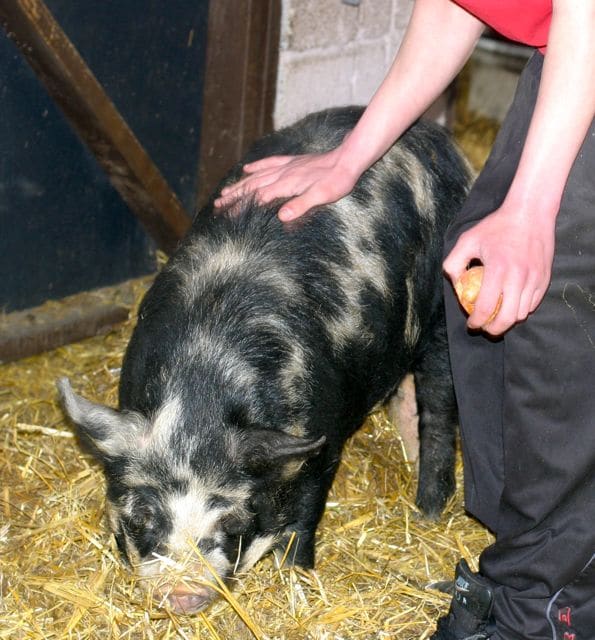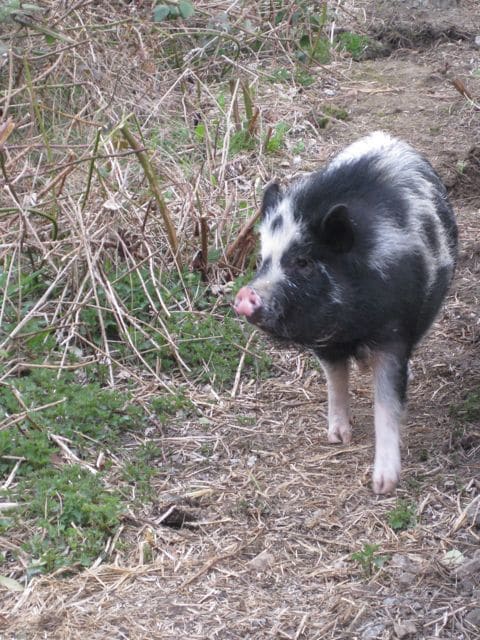Sanctuary Life
Looking after pigs
This is Peppa who is a lovely young lady pig who was rescued by us and stayed with us in the sanctuary for nearly a year. Pigs are not difficult to care for if you have the right facilities for them. So long as they are well fed and happy and in a natural environment they will do well.
Having enough room for them is the key to contentment. In their natural environment they would find a cosy den, in the roots of a big tree is a favourite spot. During the day they like to roam and dig and find things to eat – and that pigs eat almost anything is true. They enjoy a mash and like to slurp it up, a bowl of pig meal soaked with warm water to make a thick ‘porridge’ is good for them and they eat it very quickly. You can also buy ‘pig nuts’ which aren’t nuts at all but are pig pellets. These aren’t so popular but most pigs will eat them and the advantage of a specialized pig food is that it has all the nutrients in that are necessary for health.
We’ve been rescuing pigs for over 30 years and have had lots of happy endings where we’ve found good homes for them. It’s surprising how many people want to keep a pig as a pet and ensure it never goes in to the food chain! Pigs are very intelligent animals and have the nearest physiology to humans which is why they have so often been used for experimentation. Hopefully this is now in the past, we don’t believe that animal experimentation can ever be justified.
If you have a stable or a roomy shed with a paddock attached you will be able to keep a pig. The fence needs to be very secure and this will be expensive to fix. Post and rail won’t do, nor will sheep netting. Boarding the fence all round the bottom for at least a couple of feet, is the only way to keep Mrs. Pig secure. Electric fencing works brilliantly, the only trouble being that when the pig touches it she won’t go anywhere near it ever again. So trying to persuade her that it is alright to walk past the fence and through the gate can be a problem.
A shed for a pig can be a home made affair so long as it is big enough and insulated, straw is the best inner liner for a pig shed. Or you can buy an ark which is ready made and your pig will find it a cosy home. Fill the shed with several bales of straw and she will be warm and cosy all winter. You can buy plastic strips from an agricultural wholesaler and hang them over the entrance. Mrs. Pig will soon learn to push them aside and go in and out – a bit like a cat flap on a bigger scale.
If your paddock is overgrown that is so much the better. A pig will clear all the weeds and be a good gardener for you. Don’t forget a big water dish, pigs do drink a lot and also like to tip everything up to see what’s underneath. A worm or a tasty grub maybe?
Getting a full grown pig may be a bit daunting for a novice pig keeper. If left to grow they are massive creatures. Farmed pigs are slaughtered at pork or bacon weight – 20 to 25 weeks – so they never reach full size. We have rescued many frail, injured or orphaned piglets and so long as they are given lots of t.l.c. they rear on well. We’ve spent hours nursing a baby pig on our knee watching the news on the t.v.!
Pig farmers don’t always want the trouble of rearing the runt of the litter and will give them away or charge a small amount. We’ve also had piglets in with crushed feet or those that have been rejected by their mother. So long as they have had some colostrum (the first milk) they take to a baby’s feeding bottle very well. A big last feed and they’ll sleep through till morning if they are kept warm. All our pigs have been kept until old age or found good homes. Campaigning for the welfare of pigs is one of our most important agendas.
If you do take on a piglet, keeping her warm is vital. Baby pigs die of the cold very easily. We’ve resuscitated many piglets in the bottom oven of the Aga. Once they get their temperature up they do fine. A little pig may need iron injections so check with the vet. Providing a shovel full of fresh (clean) earth may do the trick. This is something to make available anyway. An infra red lamp for the baby pigs to cuddle together under is a good idea unless we’re in a heatwave.
Piglets soon learn to follow you about – you are their food source after all. House training is easy – pigs are the cleanest of animals. If you keep them in the place you want them to make their toilet, that’s it they will never make a mess anywhere else. What other animal can you house train so easily?
Getting a pig to go where you want him to is difficult unless you know how to do it. Collars and leads don’t work because the pig has such a thick neck. Pigs are very strong but it’s easy enough to move them when you have a ‘boar-board’. This is a light piece of plywood with a hand hold cut into it. You hold the board by the pigs head and he’ll walk alongside it. That was easy!
Pigs are mostly contented animals and their main thoughts in life are food and comfort. They are not difficult to care for and always pleased to see you – so long as you have a tasty treat for them. Pigs love apples especially and if a pig won’t eat an apple you can bet he isn’t well.
Don’t forget that pigs need to be ear tagged so that their movements can be recorded. You need a holding number to be able to keep pigs – ask Defra for details of how to get one. Whenever a pig is moved the authorities must be informed – familiarizing yourself with the regulations on pig movement orders and keeping a pig (even as a pet) is essential.
This is a picture of our present sanctuary pig who is called Kevin. He’s grown and put on a lot of weight since this photo was taken. Kevin has the run of a purpose made paddock and has a straw filled shed to go into when it’s bedtime. We thought he was going to be a keen gardener but he’s lost a bit of interest in digging lately – Kevin would rather eat cake!


